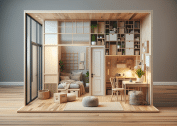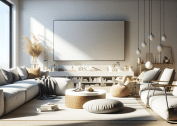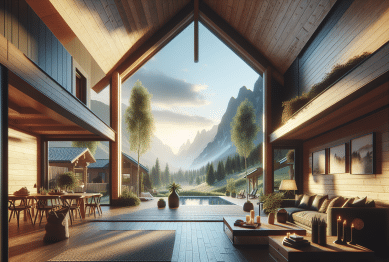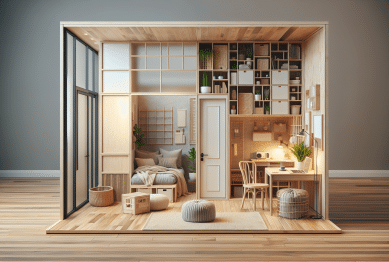Discover how the art of decluttering and mindful home design can turn any space into a personal sanctuary. This guide explores easy habits, smart design choices, and how small changes can lead to more peace and energy in daily life—perfect if you’re curious about lifestyle transformation.
Your Home as a Personal Sanctuary
Turning your home into a peaceful, decluttered retreat isn’t just about tidying up. It’s a lifestyle shift that encourages clarity, calm, and renewal. People often underestimate how much their living environment affects their mindset and stress levels. When piles of clothing and paperwork overflow, even small spaces can feel overwhelming. The concept of creating a retreat right where you live is about designing spaces that make you feel restored the minute you step inside. Simple gestures—like incorporating a mindfulness corner or choosing neutral colors—bring an instant sense of calm.
Many individuals who commit to decluttering notice improved sleep, a greater sense of control, and even enhanced creativity. Clutter competes for your attention, subtly wearing you down. By finding a place for everything and removing what you don’t need, your home begins to breathe. In this way, your daily routine becomes less stressful and more intentional. The psychology behind minimalist design supports the notion that less truly can mean more when it comes to comfort and happiness.
Smart storage solutions make things more manageable, even for busy schedules. Baskets, shelving, and multi-functional furniture all help sustain order with minimal effort. Research into home environments shows that a tidy space often leads to a clearer mind, boosting productivity and reducing anxiety. Those seeking a retreat-like environment thrive when every item has a purpose and every room feels balanced, welcoming, and just a little bit like a hidden getaway.
Decluttering Methods That Actually Work
Decluttering can sometimes feel daunting, but using proven methods makes it achievable for anyone. One popular approach is the ‘one in, one out’ rule—every new item that enters means another must leave. This keeps collections under control without requiring whole days spent sorting. Others prefer the 15-minute declutter, where a quick session targets drawers or corners. These outdoor-inspired bursts of action are much less intimidating than a full weekend overhaul.
Donation is another powerful decluttering strategy. Passing on rarely-used clothing, books, or tech gadgets to local charities supports both your local community and your own need for space. Large organizations run programs that help distribute these items to those in need, closing the loop between mindful consumption and social responsibility (https://www.feedingamerica.org). Friends and neighbors often appreciate gently used goods as well. Choosing the right outlet—thrift stores, shelters, or online swapping—can be gratifying for all involved.
Many find success in the KonMari method, which asks you to keep only items that spark joy. This technique, rooted in Japanese organizing principles, focuses less on strict minimalism and more on personal connection. It can be freeing to recognize that some belongings are ready to move on. Whichever method resonates most, consistency is key. A few minutes each week is often enough to keep clutter at bay and maintain the feeling of a true retreat at home.
Design Tips for a Calming Environment
Creating a calming home environment doesn’t require professional design skills. You can start with your senses: soothing colors, soft lighting, and comfortable textures all help set the mood. Avoiding stark overhead lights in favor of lamps and warm bulbs naturally lowers stress levels. Area rugs, throw blankets, and scented candles can transform a basic room into a comforting haven. These touches encourage relaxation after busy days.
Nature plays a leading role in home relaxation. Indoor plants boost mood, purify air, and evoke a sense of peacefulness. Even a small succulent on a desk or a few herbs on a kitchen windowsill create connection to the outdoors. Studies show that looking at greenery indoors lowers blood pressure and helps people focus—one reason why plant-filled spaces are trending in wellness design (https://www.ncbi.nlm.nih.gov/pmc/articles/PMC4419447/).
Multi-use furniture—like storage ottomans or bench seats—maximizes space and reduces clutter. Wall hooks and floating shelves keep surfaces clear, while art or meaningful photos add personality without taking up floor space. Think less about buying new objects, and more about arranging what you already own in ways that invite rest and happiness. Ultimately, a calm environment emerges from order, not excess. Your retreat is shaped by what you choose to keep and display.
Establishing Routines That Support Peace
Routines bring structure and predictability, making life’s chaos more manageable. Waking up and winding down with the same few activities anchors each day, no matter how unpredictable work or family may be. For some, a morning stretch in a sunlit corner sets a positive tone. For others, a nightly reading break signals it’s time to power down. These routines form the backbone of a peaceful lifestyle, helping you recharge overnight or start the day strong.
A decluttered space makes it easier to stick to habits. When everything has a place, it’s simpler to prepare meals, do yoga, or even just keep paperwork under control. Research suggests that functional routines in organized environments lower cognitive load and free up mental energy (https://www.apa.org/monitor/2019/09/organized-mess). That’s energy you can invest in hobbies or relationships, instead of constant searching for lost items or fighting distraction.
Technology can also play a role in sustaining routines. Setting reminders, playing calming music, or using smart lights to gently signal bedtime are small hacks that encourage continuity. Even social routines—like sharing meals at the table—benefit from decluttered environments where everyone feels relaxed. Over time, these rituals help home become not just a place to sleep, but the heart of daily renewal and self-care.
Embracing Minimalism in Entertainment Spaces
Entertainment areas, like living rooms, quickly accumulate gadgets, remotes, and media. Minimalist principles help prevent these spaces from feeling cramped. Start by paring down to essentials: a few favorite books, well-loved board games, or a streamlined media setup. When everything has a home—remote in a drawer, games in a basket—clean-up takes just seconds.
Wall-mounted TVs or floating shelves offer storage while keeping floors open. For those who enjoy gatherings, modular seating is flexible for groups but tucks away for solo downtime. Even art can multitask, doubling as acoustic dampening panels that keep the space comfortable for conversation. By prioritizing both function and comfort, entertainment spaces stay inviting but never overwhelming.
More families report using their living areas for multiple activities: movie nights, yoga, or virtual meetings. Multi-functional furniture supports this, letting a single space serve many needs. Studies indicate that clutter-free entertainment zones make people more likely to use them, rather than retreating to private rooms (https://www.ncbi.nlm.nih.gov/pmc/articles/PMC5579392/). The result is more connection, fun, and ease in daily living.
Sustaining a Decluttered Lifestyle Over Time
Long-term decluttering isn’t about a one-time overhaul but about building habits that last. Seasonal reviews—at the new year or start of a school semester—help keep possessions relevant. Some people find it helpful to keep a small donation bin handy, adding items as they outgrow their usefulness. This prevents clutter from returning and keeps the system low-pressure.
Family or roommate buy-in can make or break a decluttered home. Joint decisions on what to keep or donate foster ownership and reduce conflict. Encouraging everyone to participate turns tidying into a shared, positive experience. Communal spaces flourish when all voices are included, and routines are coordinated.
Ongoing maintenance matters more than getting everything perfect on the first try. Accept that needs change—a new hobby, job, or pet shifts what’s considered essential. Flexibility is vital. By treating decluttering as ongoing self-care rather than a chore, the benefits keep growing: more relaxation, focus, and pride in where you live. That’s how any home becomes a true retreat, season after season.
References
1. American Psychological Association. (2019). Organized Mess: Does Clutter Really Affect Our Well-Being? Retrieved from https://www.apa.org/monitor/2019/09/organized-mess
2. National Institutes of Health. (2015). Interaction with indoor plants may reduce psychological and physiological stress. Retrieved from https://www.ncbi.nlm.nih.gov/pmc/articles/PMC4419447/
3. National Center for Biotechnology Information. (2017). The Impact of Clutter on Psychological Home and Subjective Well-being. Retrieved from https://www.ncbi.nlm.nih.gov/pmc/articles/PMC5579392/
4. Feeding America. (n.d.). Get Involved: Ways to Give. Retrieved from https://www.feedingamerica.org
5. Mayo Clinic. (2023). Stress Relief from Decluttering. Retrieved from https://www.mayoclinic.org/healthy-lifestyle/stress-management/in-depth/stress/art-20046495
6. Harvard Health Publishing. (2022). The Benefits of a Minimalist Home. Retrieved from https://www.health.harvard.edu/mind-and-mood/the-benefits-of-a-minimalist-home









